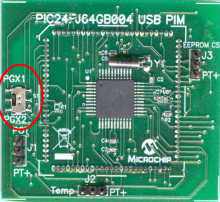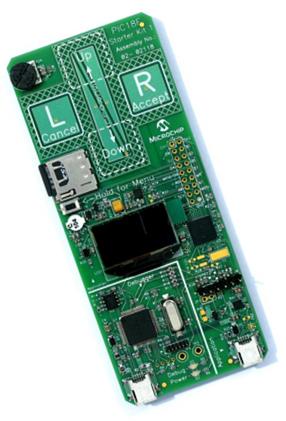Getting Started: Running the “Device
– Mass Storage – Internal Flash” demo
Configuration
1: PIC18F87J50 PIM
Configuration
3: PIC24F Starter Kit 1
Configuration
4: PIC18F46J50 Full Speed USB Demo Board
Configuration
5: PICDEM FS USB
Configuration
6: PIC18F Starter Kit
Configuration
7: PIC32 USB Starter Board
Configuration
1: PIC18F87J50 PIM
Configuration
3: PIC24F Starter Kit 1
Configuration
4: PIC18F46J50 Full Speed USB Demo Board
Configuration
5: PICDEM FS USB
Configuration
6: PIC18F Starter Kit
Configuration
7: PIC32 USB Starter Board
Required Hardware:
To run this project, you will need one of the
following sets of hardware:
Configuration 1: PIC18F87J50 PIM
PIC18F87J50
Plug-In-Module (PIM) (MA180021)
High
pin count (HPC) Explorer (DM183022)
SD
Card PICTail™ Plus Daughter Card (AC164122)
Configuration 2: Explorer 16
Explorer
16 (DM240001)
USB
PICtail™ Plus Daughter Card (AC164131)
And one of the following PIMs
PIC24FJ64GB004
Plug-In-Module (PIM) (MA240019)
PIC24FJ256GB110 Plug-In-Module (PIM) (MA240014)
PIC32MX460F512L Plug-In-Module (PIM) (MA320002)
PIC32MX795F512L Plug-In-Module (PIM) (MA320003)
dsPIC33EP512MU810 USB
Plug-In-Module (PIM)
PIC24EP512GU810 USB
Plug-In-Module (PIM)
Configuration 3: PIC24F Starter Kit 1
PIC24F
Starter Kit 1 (DM240011)
Configuration 4: PIC18F46J50 Full Speed USB Demo Board
PIC18F46J50
Full Speed USB Demo Board (MA180024)
Configuration 5: PICDEM FS USB
PICDEM
FS USB (DM163025)
Configuration 6: PIC18F Starter Kit
PIC18F Starter Kit (DM180021)
Configuration 7: PIC32 USB Starter Board
PIC32 USB Starter Board (DM320003)
Configuring the Hardware:
This
section describes how to set up the various configurations of hardware to run
this demo.
Configuration 1: PIC18F87J50 PIM
Configuration 3: PIC24F Starter Kit 1
Configuration 4: PIC18F46J50 Full Speed USB Demo Board
Configuration 5: PICDEM FS USB Board
Configuration 6: PIC18F Starter Kit
Configuration 7: PIC32MX USB Starter Board
Configuration 1: PIC18F87J50 PIM
1)
Short JP4 on the PIC18F87J50 PIM. This
allows the demo board to be powered through bus power.
2)
Short JP1 such that the “R” and “U” options are shorted.
Configuration 2: Explorer 16
1)
Before attaching the PIM to the Explorer 16 board, insure that the processor selector
switch (S2) is in the “PIM” position as seen in the image below.
2)
Short the J7 jumper to the “PIC24” setting
3)
Before connecting the PIM to the Explorer 16 board, remove all attached cables
from both boards. Connect the PIM to the
Explorer 16 board. Be careful when
connecting the boards to insure that no pins are bent or damaged during the
process. Also insure that the PIM is not
shifted in any direction and that all of the headers are properly aligned.
3a) If using the PIC24FJ64GB004 PIM, please
insure that the programming port switch is switched in the PGX1 direction.

4) On the USB PICTail Plus board, short jumper
JP1. Remove all other shorts on the
board.
5) Connect the USB PICTail Plus board to either
of the female PICTail Plus connectors or on the card edge connector (J9) at the
edge of the Explorer 16 board.
Note: When using the HID bootloader for PIC32, it is important
to modify the procdefs.ld file to relocate the sections of code that will hold
the bootloader and those sections that will hold the user application. Example modified procdefs.ld files have been
provided with each project. This file is
currently named “Procdefs.ld.boot”. When
using the example project with the bootloader it is required to remove the
“.boot” section of the file. This will
allow MPLAB to use this file instead of the default linker file. Once the linker file is renamed, however, the
project will no longer work without the bootloader. Please rename the file in order to get the
project working again with PIC32.
Configuration 3: PIC24F Starter Kit 1
The PIC24F Starter Kit does not require any hardware setup
to run this demo. This demo does,
however, require the user to change the default selected device in the project
before compiling the demo.
1) Open the associated project file
for C30
2) In MPLAB Select
“Configure->Select Device”
3) In the device list box in the top
left corner of that window, select “PIC24FJ256GB106”
Configuration 4: PIC18F46J50 Full Speed USB Demo Board
1) Short JP3 to allow the board to
be powered from the USB.
.jpg)
Configuration 5: PICDEM FS USB
1)
If using the
PICDEM FS USB Demo Board, no hardware related configuration or jumper setting
changes should be necessary. The demo
board need only be programmed with appropriate firmware.
Configuration 6: PIC18F Starter Kit
No specific hardware configuration is required for this
demo.

Configuration 7: PIC32 USB Starter Board
No specific hardware configuration is required for this
demo.

To
run this project, you will need to load the corresponding firmware into the
devices. There are two methods available
for loading the demos: Precompiled demos and source code projects.
Precompiled
Demos are available in the “<Install Directory>\USB – Precompiled Demos”
folders. Each demo should be prefaced
with the hardware platform it is compiled for.
Select the file that matches the hardware that you have and the demo
that you want to run. For more
information about how to load a precompiled project, please see the “Getting
Started – Loading a precompiled demo” guide.
The
source code for this demo is available in the “<Install Directory\USB Device
– Mass Storage – Internal Flash” directory.
In this directory you will find all of the user level source and header
files as well as project and workspace files for each of the hardware
platforms. Find the project (*.mcp) or
workspace (*.mcw) file that corresponds to the
hardware platform you wish to test.
Compile and program the demo code into the hardware platform. For more help on how to compile and program
projects, please refer to the MPLAB® IDE help available through the help menu
of MPLAB (Help->Topics…->MPLAB IDE).
Please
note that when using either the C30 or C32 demo projects you will be required
to select the correct processor for the demo board.
1) Open the associated project file
2) In MPLAB Select
“Configure->Select Device”
3) In the device list box in the top
left corner of that window, select the desired device.
This
demo uses the selected hardware platform as an drive
on the computer using the internal flash of the device as the drive storage
media. Connect the hardware platform to
a computer through a USB cable.
The
device should appear as a new drive on the computer named “Drive Name”. The volume label or file information can be
changed in the Files.c file located in the project
directory.
Issue 1: The device appears correctly in the device
manager, but no new drive letters appear on a Windows® operating system based
machine.
Solution: See Microsoft knowledge base article
297694:
http://support.microsoft.com/kb/297694
If
there is a drive letter conflict (ex: because a network drive has been mapped
to a letter low in the alphabet), on some operating systems the newly attached
USB drive may not appear. If this
occurs, either obtain the hotfix from Microsoft, or remap the conflicting
mapped network drive to a letter at the end of the alphabet (ex: Z:).
Issue 2: The
device enumerates correctly and I can access the new drive. Even though the drive is not full yet, when I
try to write to the drive, I get an error message something like, “Cannot copy
(some name): The directory or file cannot be created.”
Solution: In order to
copy new files onto the drive volume, both the file contents themselves must be
copied to the drive, and the FAT table must also be updated in order to
accommodate the new file name and path.
Even if the drive has plenty of free space available, the FAT table may
have reached its limit. In order to keep
the default demos small, the FAT table is configured to be only 512 bytes
long. This is not very large, and can
easily be exceeded, especially if the files on the drive have long file
names. In order to use the remaining
space available on the drive, it is recommended to keep the individual file
names as short as possible to minimize their size in the FAT table. Alternatively, the firmware can be modified
so that the FAT table is larger, and therefore able to accommodate more file
name and path characters.
Issue 3: When I try to format the drive, I get an error
message and the drive does not get formatted properly.
Solution: By default, common Windows based operating systems
will try to place a large FAT table on the newly formatted disk (larger than
the default 512 bytes of the demo firmware).
If the FAT table is larger than the total drive space, the drive cannot
be formatted. In order to successfully
format the drive, an alternative method of formatting will be needed that
places a smaller FAT table on the drive.
For example, the drive can be effectively reformatted by reprogramming the
microcontroller with the original HEX file.
Alternatively, if the firmware is modified to increase the total drive
space, the Windows operating system managed FAT table may be able to fit. Unfortunately, this will shrink the effective
drive size, making less of it available for actual file data.
Issue 4: When I format the drive, the drive size shrinks.
Solution: See the solution to issue #3 above.
Trademarks:
The Microchip name and logo, the Microchip logo,
MPLAB, and PIC are registered trademarks of Microchip Technology Incorporated
in the
PICDEM and PICTail are
trademarks of Microchip Technology Incorporated in the
Microsoft, Windows, and
Windows Vista are either registered trademarks or trademarks of Microsoft
Corporation in the
SD is a trademark of the SD Association in the
U.S.A and other countries


.JPG)
.JPG)
.JPG)
